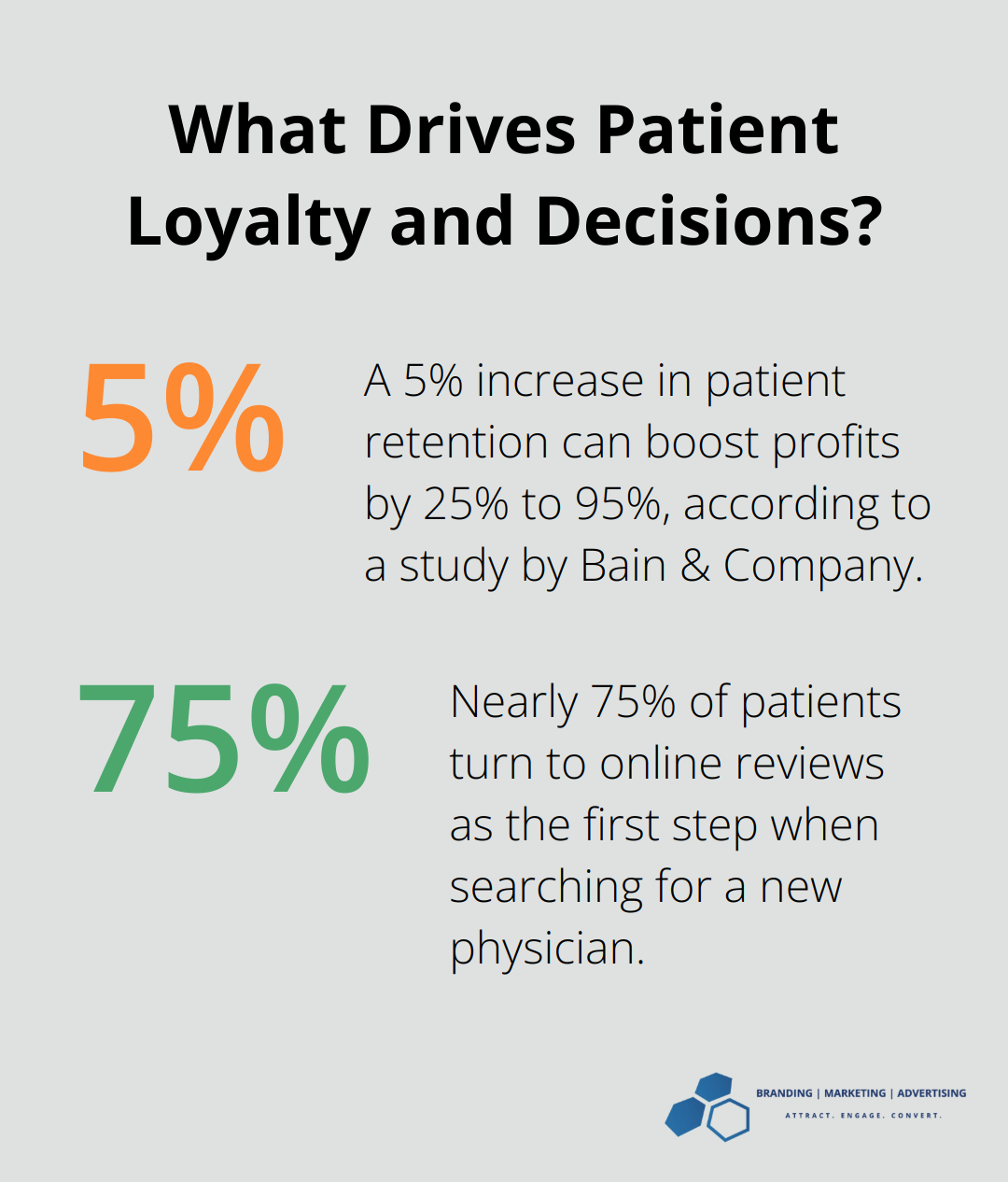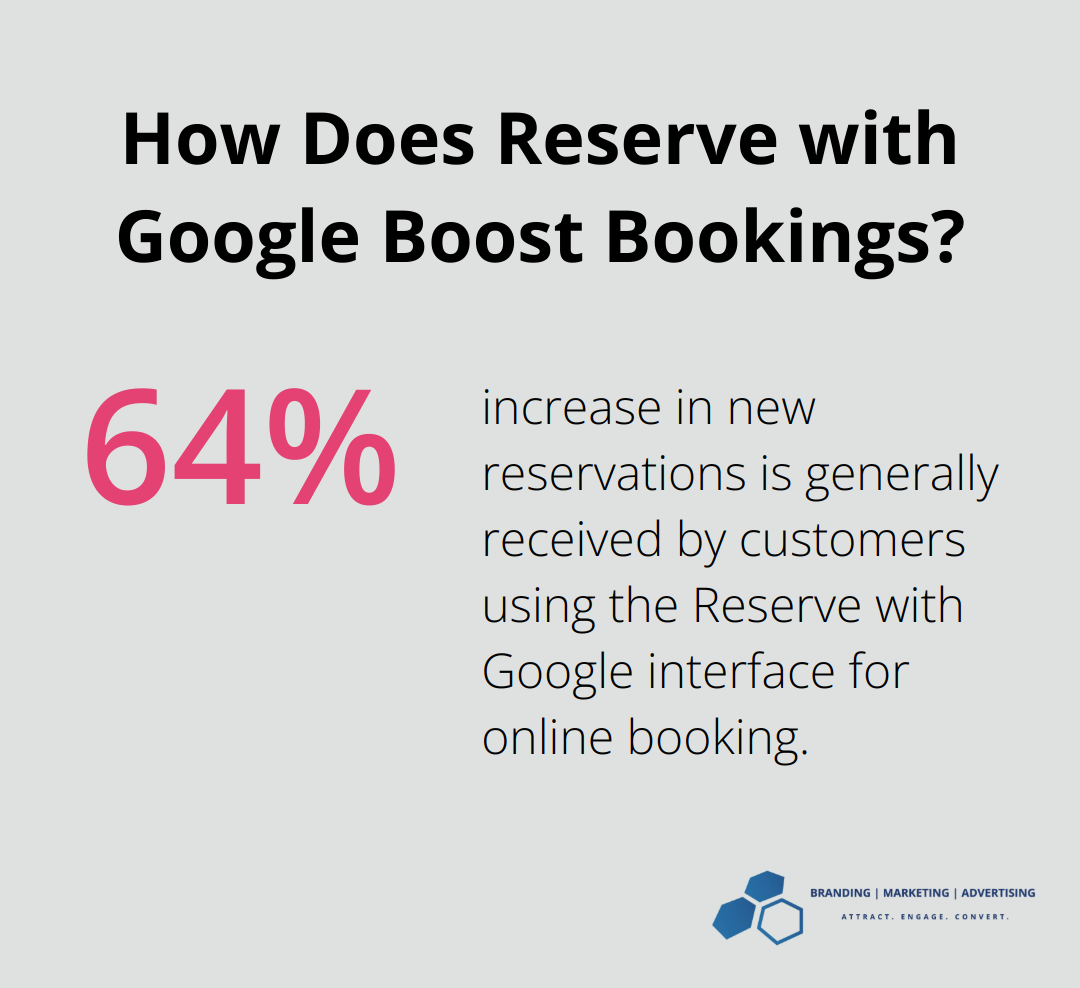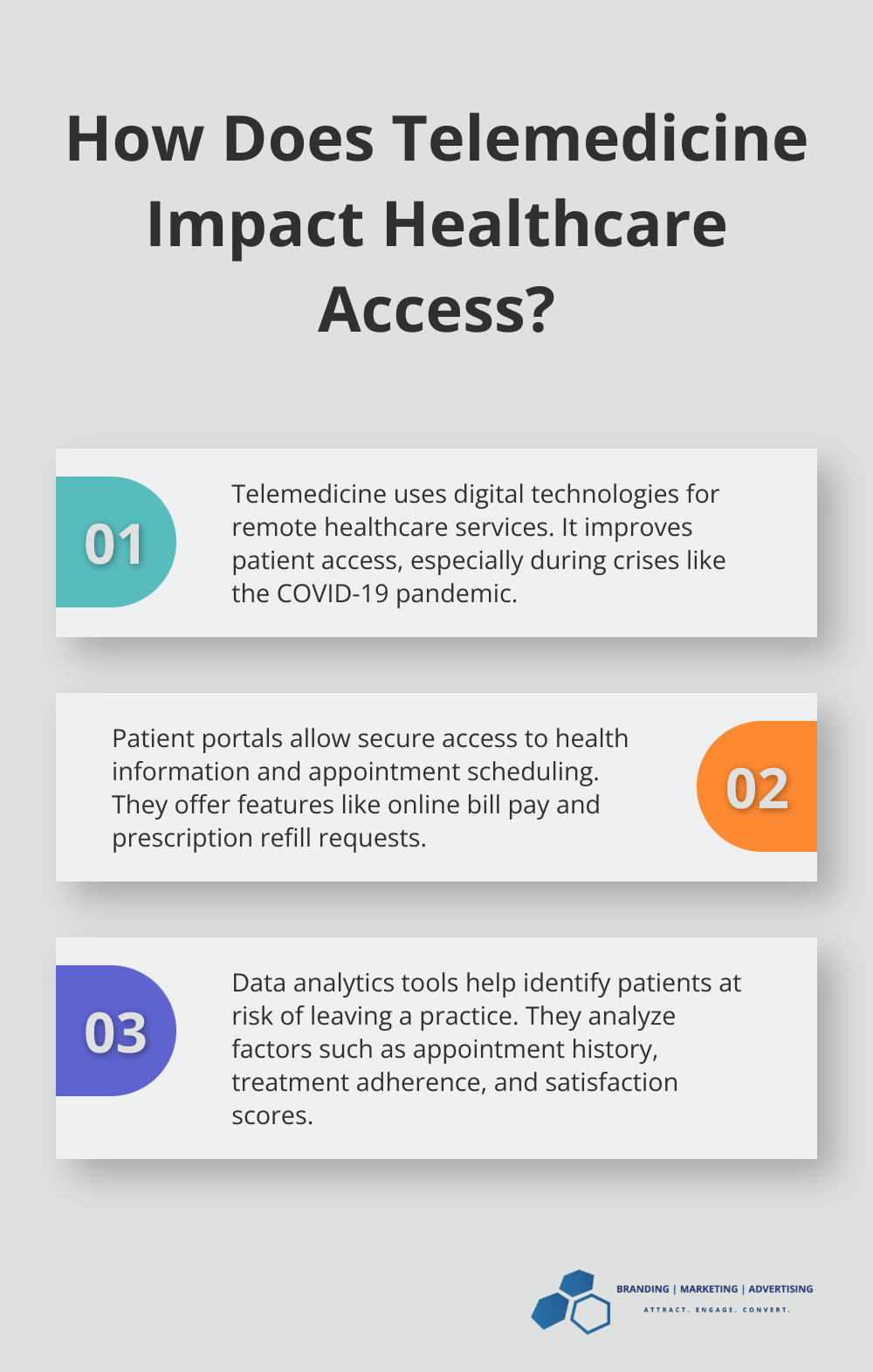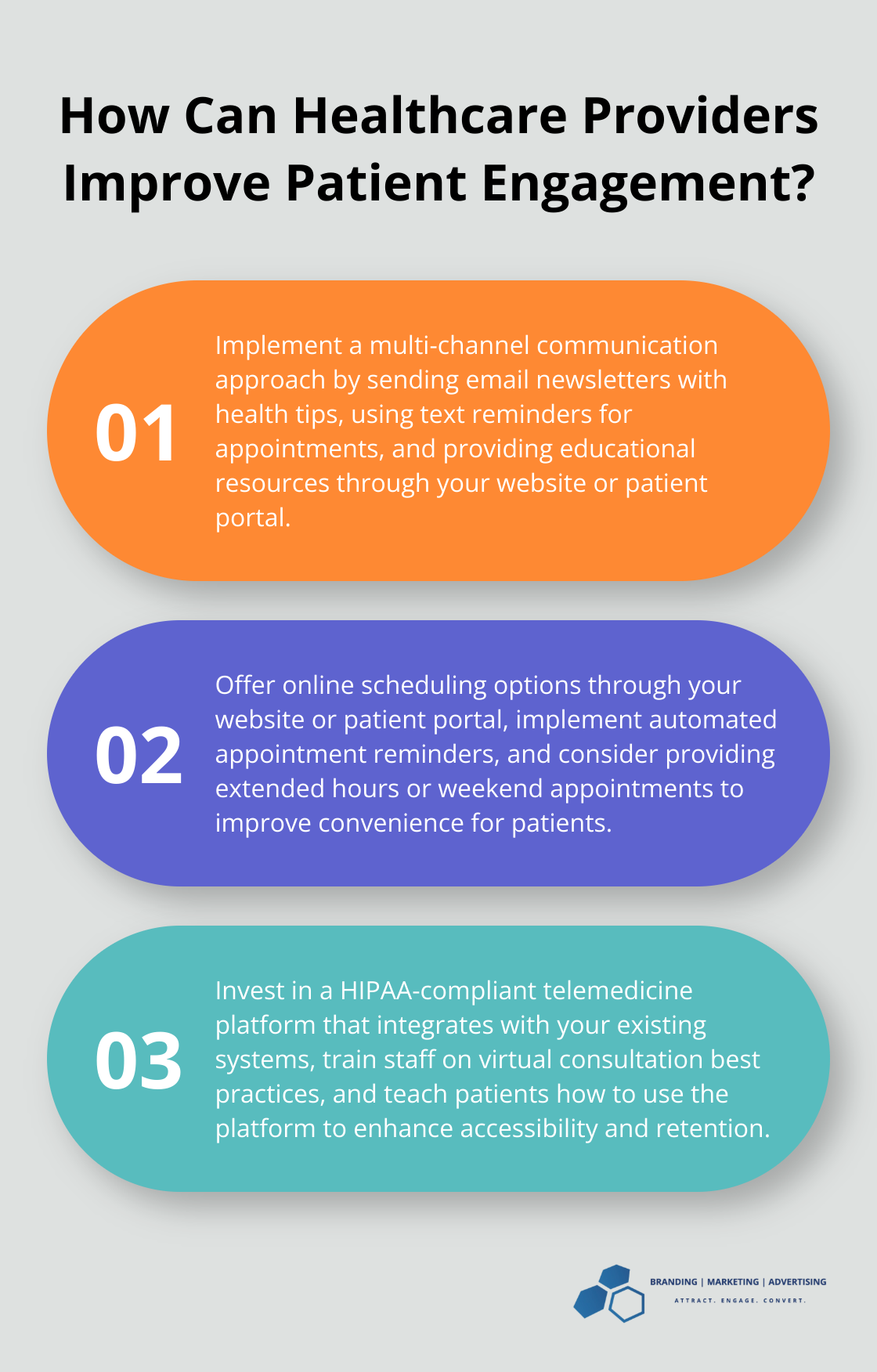Why Patient Retention is Crucial for Healthcare Practices
At Branding | Marketing | Advertising, we understand the critical role patient retention plays in the success of healthcare practices.
Patient retention goes beyond just keeping a full appointment book. It’s about building lasting relationships, improving health outcomes, and ensuring the long-term stability of your practice.
In this post, we’ll explore why patient retention matters and share practical strategies to keep your patients coming back.
Why Patient Retention Matters
Patient retention forms the foundation of a successful healthcare practice. Let’s explore its importance and how it can transform your medical business.
The Financial Impact of Patient Retention
Acquiring a new patient costs 6 to 7 times more than retaining an existing one. This stark difference underscores why patient retention is a smart financial move. A study by Bain & Company reports that a 5% increase in retention can boost profits by 25% to 95%. For healthcare providers, this translates to significant savings and increased revenue stability.
Continuity of Care Improves Outcomes
Patient retention isn’t just about finances-it’s about providing better care. When patients stay with one provider, it allows for more comprehensive, continuous care. A study in the Annals of Family Medicine demonstrated that patients with continuity of care had lower mortality rates. This occurs because providers can track health changes over time, identify issues early, and create more personalized treatment plans.
Trust Grows Through Familiarity
Trust forms the bedrock of any strong doctor-patient relationship. Returning patients develop a rapport with staff and providers. This familiarity breeds trust, which leads to better communication. Patients who trust their healthcare providers are more likely to adhere to treatment plans and be honest about their health concerns.
The Ripple Effect of Satisfied Patients
Happy patients don’t just return-they bring others with them. Word-of-mouth referrals wield significant power in healthcare. Nearly 75% of patients turn to online reviews as the first step when searching for a new physician. Focusing on retention and satisfaction not only keeps current patients but also attracts new ones (a win-win situation for any practice).
Efficiency Improves as No-Shows Decrease
Loyal patients are more likely to keep their appointments. This reduces no-show rates, which can cost practices an average of $200 per missed appointment. Lower no-show rates result in smoother operations, better resource utilization, and more efficient care delivery.

Patient retention creates a healthcare experience that patients value and trust. It’s not just about keeping people coming back-it’s about building a more stable practice and contributing to better health outcomes for your community. As we move forward, let’s explore effective strategies to enhance patient retention in your healthcare practice.
Proven Strategies to Boost Patient Retention
Patient retention requires a multifaceted approach. We’ve identified key strategies that consistently yield positive results. Let’s explore these tactics to help your practice keep patients coming back.
Clear and Consistent Communication
Effective communication forms the foundation of patient retention. Higher patient satisfaction rates have been associated with better retention to care, better adherence to management plans, and loyalty toward the institution. To address this, implement a multi-channel approach:
- Send email newsletters with health tips and practice updates.
- Use text reminders for appointments and follow-ups.
- Provide educational resources through your website or patient portal.

Tailor your communication style to different patient demographics. Older patients might prefer phone calls, while younger ones may opt for text messages or app notifications.
Robust Feedback System
Patient feedback drives improvement. Here’s how to leverage feedback:
- Send post-appointment surveys via email or text.
- Use tools like Net Promoter Score (NPS) to measure patient satisfaction.
- Respond promptly to online reviews (both positive and negative).
- Create an action plan to address common concerns raised in feedback.
Active feedback collection and response shows patients that their opinions matter, fostering loyalty and trust.
Streamlined Scheduling and Appointment Processes
Convenience matters in today’s fast-paced world. Customers that use the Reserve with Google interface for online booking generally receive a 64% increase in new reservations. Consider these improvements:
- Offer online scheduling options through your website or a patient portal.
- Implement automated appointment reminders via text or email.
- Provide extended hours or weekend appointments for busy patients.
- Consider telehealth options for follow-ups or minor consultations.
These measures improve patient satisfaction and reduce no-show rates.
Personalized Patient Care and Follow-ups
Personalization significantly impacts healthcare outcomes. Here’s how to personalize your approach:
- Use patient data to tailor health recommendations and reminders.
- Implement a system for regular check-ins (especially for patients with chronic conditions).
- Offer personalized health education materials based on each patient’s specific needs.
- Train staff to remember and use patient preferences in interactions.
This personalized approach creates a strong bond that encourages loyalty and repeat visits.
These strategies require effort and resources, but the payoff in patient retention and practice growth proves substantial. Consistency remains key as you work on these areas. The next chapter will explore how technology can further enhance your patient retention efforts, creating a seamless and engaging healthcare experience.
How Technology Boosts Patient Retention
Technology plays a pivotal role in enhancing patient retention in today’s digital age. The right tech tools can transform patient experiences and keep them coming back. Let’s explore some game-changing technologies that can significantly boost your patient retention rates.
Patient Portals: Your Digital Front Door
Patient portals have become indispensable for modern healthcare practices. These secure online platforms allow patients to access their health information, schedule appointments, and communicate with their healthcare providers. A comprehensive review examined the impact of electronic health records (EHRs) on patient care and outcomes, highlighting key findings from existing literature.

To maximize the benefits of patient portals:
- Make your portal user-friendly and mobile-responsive
- Offer features like online bill pay and prescription refill requests
- Update the portal regularly with relevant health information and resources
Telemedicine: Breaking Down Barriers to Care
Telemedicine has revolutionized healthcare accessibility. Recent research has shown that telemedicine uses digital technologies to provide healthcare services remotely, greatly improving patient access, especially during crises like the COVID-19 pandemic. This technology improves patient convenience and enhances retention by reducing barriers to care.
To implement telemedicine effectively:
- Select a HIPAA-compliant platform that integrates with your existing systems
- Train your staff on virtual consultation best practices
- Teach patients how to use the telemedicine platform
Data Analytics: Predicting and Preventing Patient Churn
Data analytics tools help you identify patients at risk of leaving your practice. You can proactively address issues before they lead to patient attrition by analyzing factors like appointment history, treatment adherence, and satisfaction scores.
To leverage data analytics:
- Invest in a robust healthcare CRM system
- Set up automated alerts for at-risk patients
- Develop personalized outreach programs based on analytics insights
Technology is a powerful tool (when combined with a patient-centered approach). The right tech tools create a more engaging, accessible, and personalized healthcare experience that keeps patients coming back. Try integrating these technologies seamlessly into your patient retention strategies for optimal results.
Final Thoughts
Patient retention forms the cornerstone of success for healthcare practices. It improves health outcomes through continuity of care, increases practice revenue, and enhances overall stability. Effective strategies include clear communication, robust feedback systems, streamlined scheduling, and personalized care (all contributing to a positive healthcare experience).

Technology plays a key role in modern patient retention efforts. Patient portals, telemedicine, and data analytics tools offer innovative ways to engage patients and improve accessibility. These technologies help predict potential issues before they lead to patient attrition, fostering trust between providers and patients.
At Branding | Marketing | Advertising, we understand the importance of patient retention in healthcare. Our team can help you develop and implement effective digital marketing strategies tailored to your practice’s unique needs. We strive to keep you connected with your patients and support you in providing exceptional care.












